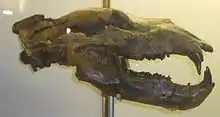Ursus etruscus
Ursus etruscus (the Etruscan bear) is an extinct species of bear, endemic to Europe, Asia and North Africa during the Pliocene through Pleistocene, living from ~5.3 million to 100,000 years ago.
| Ursus etruscus | |
|---|---|
 | |
| Fossils | |
| Scientific classification | |
| Kingdom: | Animalia |
| Phylum: | Chordata |
| Class: | Mammalia |
| Order: | Carnivora |
| Family: | Ursidae |
| Genus: | Ursus |
| Species: | U. etruscus |
| Binomial name | |
| Ursus etruscus Cuvier, 1823 | |
Ursus etruscus appears to have evolved from Ursus minimus and gave rise to the modern brown bear, Ursus arctos, and the extinct cave bear, Ursus spelaeus.[1] The range of Ursus etruscus was mostly continental Europe with specimens also recovered in the Great Steppe region of Eurasia. Fossil evidence for Ursus etruscus was recovered in Palestine, Croatia, and Tuscany, Italy.
Some scientists have proposed that the early, small variety of U. etruscus of the middle Villafranchian era survives in the form of the modern Asian black bear.[2]
Morphology

Not unlike the brown bears of Europe in size, it had a full complement of premolars, a trait carried from the genus Ursavus.
Fossil distribution
Sites and specimen ages:
- Vassiloudi, Macedonia Greece ~5.3–1.8 Ma.
- Obigarm, Tajikistan ~5.3–1.8 Ma.
- Ahl al Oughlam, Morocco ~3.6–1.8 Ma.
- Pardines, Auvergne, France ~2.5–1.8 Ma.
- Dmanisi, Georgia ~1.8 Ma–800,000 years ago.
- Mestas de Con, Cangas de Onis, Asturias, Spain ~1.8–100,000 years ago.[3]
- Strmica, Croatia
References
- De Torres Pérez-Hidalgo, Trinidad José (1992). "The European descendants of Ursus etruscus C. Cuvier (Mammalia, Carnivora, Ursidae)". Boletín del Instituto Geológico y minero de España. 103 (4): 632–642.
- Herrero, Stephen. "Aspects of Evolution and Adaptation in American Black Bears (Ursus americanus Pallas) and Brown and Grizzly Bears (U. arctos Linné) of North America" (PDF). Bears: Their Biology and Management. 2: 221–231. doi:10.2307/3872586. JSTOR 3872586. Retrieved 12 December 2020.
- Paleobiology Database: Mestas de Con, Cangas de Onis collection
Further reading
- Hanni, Catherine; Laudet, Vincent; Stehelin, Dominique; Taberleto (1994). "Tracking the origins of the cave bear (Ursus spelaeus) by mitochondrial DNA sequencing" (PDF). Proc. Natl. Acad. Sci. USA. 91: 12336–12340.